
MONA: Theatre of the World
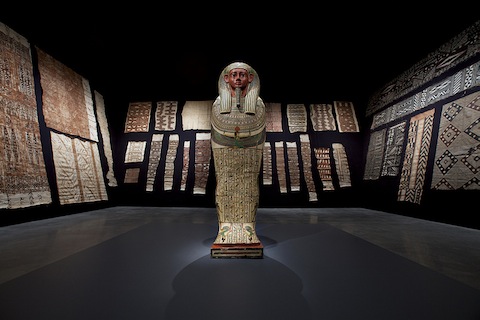
Above: Barkcloth Room with Coffin of Iret-Heru-ru Egypt, late 26th Dynasty, c. 600–525 BCE. Photo Credit: MONA/Rémi Chauvin Image Courtesy MONA Museum of Old and New Art, Hobart, Tasmania, Australia
MONA by day is a little less dreamlike, but no less otherworldly. While umbilically connected to Hobart’s historic waterfront hub by regular buses and ferries, the architecturally exotic, privately owned art museum stands apart. Global art tourists flock here – collectors, curators, devotees of all things cutting edge and contemporary in their beautifully made dark Rick Owens clothes, slender shoes and glossy haircuts, mingling with Taswegians and mainlanders in half-lit subterranean chambers. It’s as if the ferry (the very best way to arrive at MONA), in taking you up the Derwent River crosses into another zone. The Twilight Zone perhaps, or like Charon ferrying the dead across the river Styx, a journey into the underworld.
Much has been written about multi-millionaire David Walsh’s fascination with sex and death, two of the defining creative drivers of humanity. In his ever-growing and ever-changing collection, the careful placement of ancient art alongside contemporary practice is inspired. There’s certainly a darkness to Walsh’s vision (funereal urns, sarcophagi, even the galleries lie under the earth) and a confronting sense of the body (Wim Delvoye’s stinky Cloaca) but with the dark, comes shining light – tiny Grecian gold coins presented on pins, star maps and a sunlit Anselm Kiefer pavilion.
Theatre of the World both complements and extends MONA’s vision. It enlarges MONA’s scope. It expands the museum space, literally and emotionally and existentially. It’s an inventive, surprising, sometimes witty and sometimes shocking and mostly wondrous exhibition that’s gotten excellent reviews. (Frieze magazine http://www.frieze.com/issue/review/theatre-of-the-world/ and the notoriously critical John Mcdonald among others - http://www.smh.com.au/entertainment/art-and-design/dead-will-rise-20120628-213en.html)
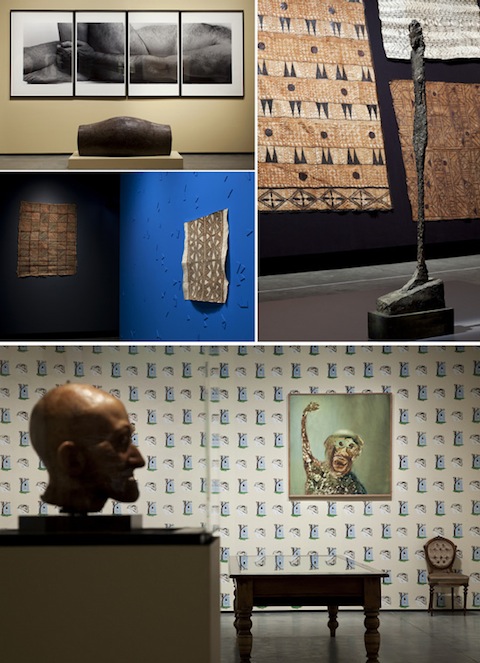
Above from top left clockwise: Self Portrait 1990, John Coplans, MONA and Lali (gong), Fiji, 19th century – early 20th century Vesi (Intsia bijuga) wood 43 x 101 x 40 cm, Tasmanian Museum and Art Gallery; Barkcloth gallery and 'Grande figure (Femme Leoni)', 1947, Alberto Giacometti; Contention Gallery, Various artworks, objects and artefacts from both MONA and TMAG's collections; Barkcloth: Siapo mamanu Samoa, and 'painting as visitor, as neighbour, definition/ method no. 503', 2011, actualisation at Mona 2012 & barkcloth no. 234, Claude Rutault. Photo Credit: MONA/Rémi Chauvin Image Courtesy MONA Museum of Old and New Art, Hobart, Tasmania, Australia
The backstory goes to the heart of the exhibition and of MONA itself. In his catalogue preface David Walsh writes how fundamental the Tasmanian Museum and Art Gallery was, and is, to a sense of himself in the world. As a teenager, he used to skive off Mass to go to there. He says: “TMAG (now the abbreviations are de rigueur) inculcated in me a respect for history, and inoculated me against trivial perspectives. Most displays changed rarely. Many are changing for the first time since I saw them, now—thirty-five years later—after an injection of public funds. But that didn’t matter, it meant that I learned them like one learns a song, through repeated exposure, and as I sang them to myself my interest grew deeper.”
In Theatre of the World, items from TMAG (currently undergoing a massive $200 million dollar redevelopment) and MONA (Walsh’s personal collection) are combined, with addition of some important artworks on loan from other institutions, notably Picasso’s Weeping Woman from Australia’s National Gallery of Victoria, Leger’s l’a bicyclette from the Art Gallery of NSW and Giacometti’s Grande Figure (Femme Leoni) from France’s Foundation Maeght.
The curator, Jean-Hubert Martin, known for his groundbreaking, innovative and globally inclusive exhibitions at the Centre Pompidou in Paris and the Venice Biennale, terms this, his newest achievement, a “museum of enchantments”. In his catalogue essay, he provides a framework: Theatre of the World is drawn from the Italian 16th Century Theatre of Memory created by scholar Giuilo Camillo, an esoteric attempt to give concrete form to human knowledge. Jean-Hubert Martin and his collaborators, including talented Dutch curator Mattis (Tjis) Vissier and the curatorial teams of MONA and TMAG, use Camillo’s philosophy as a starting point, to be made large, inhabited, decorated and embellished with strange, familiar, curious, rare, unique, prosaic and valuable things.
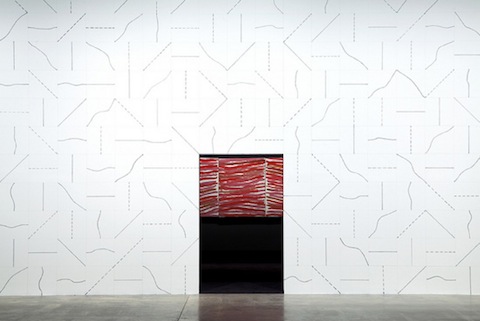
Above: Drawing #394, Sol LeWitt and No Title (Awelye) 1994, Emily Kame Kngwarreye Anmatyerre. Photo Credit: MONA/Rémi Chauvin Image Courtesy MONA Museum of Old and New Art, Hobart, Tasmania, Australia
I admit: the first few rooms of Theatre of the World almost defeated me. There is just so much going on. So much resonates, such curious juxtapositions to encourage reflection, metaphor and poetic association, as well as the questioning process of compare and contrast. Not just the extravagant array of exhibits, but the various ways they are presented; the elaborate set design of each room – different coloured walls or wallpapers, glass cases, plinths (even a bed) boxed in walls, narrow doorways or low ones or wide ones, softly lit or moodily or darkly or brightly lit, displays shown at every height from floor to ceiling. The many works on display are drawn from many categories: natural history, cultural history, social history, cartography; collections of ancient coins, pottery, fabrics, shells, Tasmanian collectable furniture, colonial painting, tribal masks, Aboriginal art, ancient art, famous masterpieces and cutting-edge contemporary western practice …. On one level, the entire thing is an exercise in resisting categorisation. Like the encyclopaedic anatomy in literature (Burton’s The Anatomy of Melancholy, Laurence Sterne’s The Life and Opinions of Tristam Shandy) the exhibition seems fascinated with an intrinsic paradox: the usefulness of categories and the ultimate futility of them.
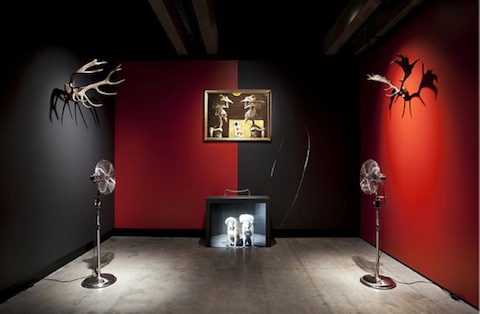
Above: Duet Room (Various Artworks) including works by Zilvinas Kempinas, Albert Tucker and William Wegman. Photo Credit: MONA/Rémi Chauvin Image Courtesy MONA Museum of Old and New Art, Hobart, Tasmania, Australia
Those first eclectic rooms with their references to the multiplicity of histories, maps and mythologies of being in the world and to the process of looking itself (mirrors, peepholes, lenses, the eye, the eyeball being sliced in Bunuel’s Surrealist film) had me trying too hard, straining to see. I felt trapped inside the wunderkammer (instead of more properly outside looking in), clumsy, fumbling to make connections, groping around like Alice for a teeny tiny key.
A critical moment of simple ease in the rooms devoted to patterning and abstraction (we all have our comfort zones!) enabled me to click in to a kind of rhythm, a loose and yet lucid focus, and backtrack through the galleries to the beginning and start again, wandering through in a kind of trusting daze, a heightened almost drug-like state where some exhibits loomed large and expanded and engrossed my attention (a shining nautilus shell, a gold Lucio Fontana like a perforated egg, a Sam Francis drawing, a Julie Rapp photograph, brain coral, a compelling installation by Jason Shulman, John Dempsey watercolours, a tiny Roman bronze Leda and Swan) and others drifted by peripherally, at the reedy fringes of consciousness, as if I were being carried by a gentle, invisible current.
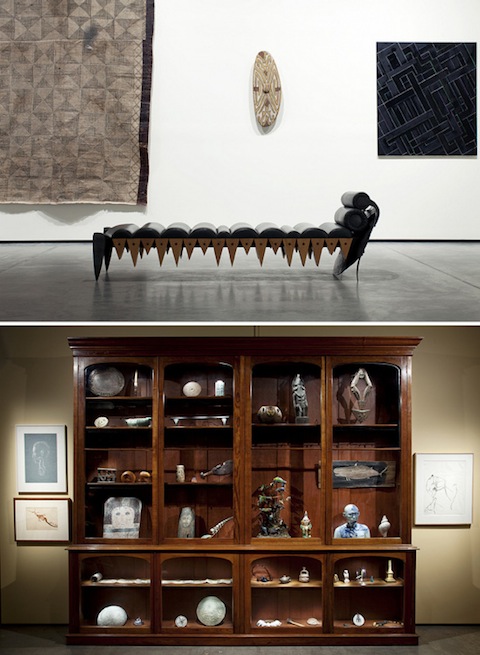
Above from top: Chaise, 1992 et al. Various works including Chaise, 1992 Wayne Hudson; Cabinet of curiosities, various artworks, artefacts and objects from both the MONA and TMAG collections. Photo Credit: MONA/Rémi Chauvin Image Courtesy MONA Museum of Old and New Art, Hobart, Tasmania, Australia
The current eddies, swirls and slows. Inside a vast black-painted chamber, time pools. High walls slope disconcertingly inward, hung with powerful, mysterious tribal barkcloths, from Fiji, Samoa, The Solomon Islands, New Guinea, some dated as early as 1850. At one end of the chamber stands an Egyptian mummy case richly decorated with paintings and hierogylphs, the coffin of Iret-Heru-ru c.600-525 BC. At the other stands Alberto Giacometti’s attenuated, existential bronze sculpture “Femme Leoni” 1947. Electricity seems to crackle between them.
I feel as if I’m in a great Ark holding the beginnings of language, the foundation of all human knowledge. I lie on one of the large flat black beanbags on the floor of the chamber and spend thrilling, associative moments spiralling upwards.
On the MONA O (the ipod guide) Jean-Hubert Martin speaks of the display (titled Majesty) in terms of the body – the sarcophagus and the Giacometti as two significant ways humans have portrayed and used the body over time, and that in one or two of the tapa cloths, in amongst the symbolic patterning, rare literal depictions of the human figure can be found. The body, language, the body. This is why I look at art, I think, all these months later at the turn of a new year; this is why I read.

- Susie Burge, all rights reserved.Above: Barkcloth Room with Coffin of Iret-Heru-ru Egypt, late 26th Dynasty, c. 600–525 BCE. Photo Credit: MONA/Rémi Chauvin Image Courtesy MONA Museum of Old and New Art, Hobart, Tasmania, Australia
All images as credited, courtesy of MONA, TMAG & Susie Burge
ATL’S CONCISE HOBART:
Best café for breakfast = Pigeonhole www.pigeonholecafe.com.au
Best teahouse = Chado Way of Tea 134 Elizabeth Street, Tel. (03) 6231 6411
Best relaxed lunch = Mona Wine Bar www.mona.net.au
Best dinner = Ethos www.ethoseatdrink.com
Best to-die-for Sunday lunch = Garagistes www.garagistes.com.au
Best Salamanca food = Smolt www.smolt.com.au The Common Ground www.thecommonground.com.au
Cool shop: The Maker www.themakerhobart.com.au
Crafty shop: Country Women’s Association Gift Shop in Elizabeth Street www.cwaintas.org.au
Hotels: Good value, modern = Hotel Collins www.hotelcollins.com.au or Fancy pants = Henry Jones Art Hotel www.thehenryjones.com
Best Art Museum: MONA www.mona.net.au
Best Museum: TMAG (currently undergoing major renovation) www.tmag.tas.gov.au
Best Exhibition: Theatre of The World (on till April 8, 2013) www.mona.net.au
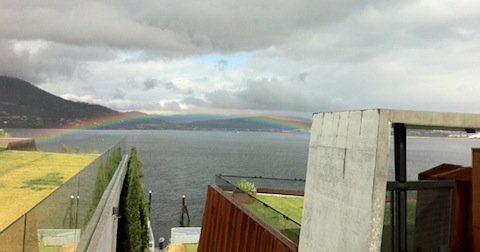
Above: Follow the rainbow to MONA. Image: Susie Burge
Best summer festival: MOFO (full acronym: MONA FOMA - Festival of Music and Art) www.mofo.net.au coming up January 16-20th, 2013. Book now. Under the direction of brilliant entrepreneurial rocker Brian Ritchie, the headline festival act in 2013 is legend David Byrne, the amazing Amanda Palmer returns, plus writer Neil Gaimon, and loads more. Elvis Costello is playing a MOFO encore. The art is curated by clever MONA duo Nicole Durling and Oliver Varenne.
Best Winter Festival: Festival of Voices www.festivalofvoices.com (5-14 July 2013) is a diverse musical event (including masterclasses & workshops as well as concerts) that takes over Hobart each year. The festival has blossomed under the creative auspices of performing arts director Kris Stewart. It now includes cabaret and burlesque, jazz and alternative music as well as choral, gospel and acapella across multiple venues and pop-ups throughout the city. Important Note: in 2013 the inaugural Dark MOFO (14-24 June) is to join the Festival of Voices making Hobart the place to be in winter 2013. Save the dates.
For more Tasmania: www.discovertasmania.com www.eventstasmania.com
- Susie Burge, all rights reserved.